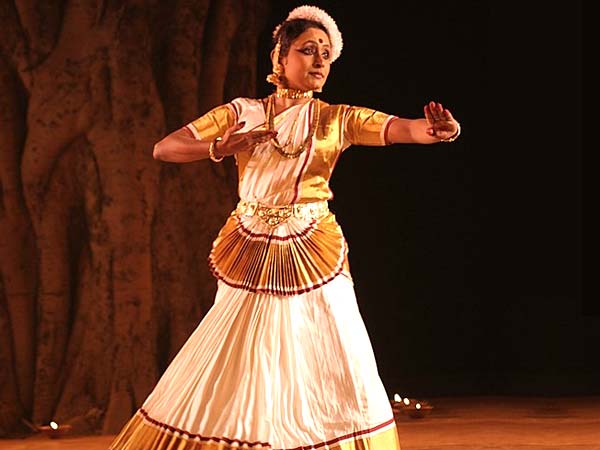Mohiniattam is a famous Indian classical dance form. Read further to know about Mohiniattam classical dance of India.
Mohiniattam Dance Form

Mohiniattam, in literal terms, means Mohini's dance.
Mohini, according to Indian mythology, is a very beautiful woman, who
attracts people instantly. She is regarded as an enchantress and thus,
Mohiniattam is the dance of the enchantress. It is believed to have been
named after Lord Vishnu, who had disguised himself as 'Mohini', with an
intention to slay Bhasmasura and during the churning of nectar from the
ocean as well. However, the basis of this dance is not seduction alone.
It also signifies transformation of Lord Vishnu into a female form and
also the concept of 'Ardhnareeshwara' i.e. male and female as one. Like
many other dance forms, it is essentially dedicated to the love and
devotion towards God and was restricted to the Devadasis.
History
The first reference to Mohiniattam has been found in 'Vyavaharamala',
composed by Mazhamangalam Naryanam Namboodiri, assigned to the 16th
century A.D. In 19th century, Swati Thirunal, the king of erstwhile
Travancore, tried to encourage the development of this dance style.
After him, Mohiniattam suffered heavily, owing to the exploitation by
the Satraps and the Landlords. Poet Vallathol revived it once again and
gave it a prominent status throughout Kerala, through Kalamandalam,
which he founded in 1930. Kalamandalam Kalyaniamma and Chinnammu Amma
are the last links of a disappearing tradition that nurtured aspirants
in the discipline at Kalamandalm.
Theme & Format
The theme of Mohiniattam is love and devotion to god. Lord Vishnu or
Krishna is the hero in most of the recitals. The spectators feel His
invisible presence when the heroine or her maid details dreams and
ambitions, through the circular movements, delicate footsteps and subtle
expression. The dancer, with the slow and medium tempos, is able to find
adequate space for improvisations and suggestive bhavas. In format, this
dance is similar to Bharatanatyam. The movements are as graceful as
Odissi. Mohiniattam, like many other dance forms, follows the Hastha
Lakshandeepika, as a text book for Mudras, or hand gestures.
Repertoire & Steps
Mohiniattam, essentially a solo dance, is nowadays being performed in
groups as well. The repertoire of Mohiniattam closely follows that of
Bharatanatyam. Beginning with Cholkettu, the dancer performs
Jathiswaram, Varnam, Padam and Thillana in a concert. Varnam combines
purity and expression in dance, while Padam tests the histrionic talent
of a dancer and Thillana exposes her technical artistry. The basic dance
steps are the Adavus which are of four kinds: Taganam, Jaganam, Dhaganam
and Sammisram. These names are derived from the nomenclature called
Vaittari.
Make-up, Costume & Music
Mohiniattam maintains realistic make-up and simple dressing. The
costumes used in dance are sober and attractive. The dancer is attired
in a beautiful white and gold-bordered Kasavu saree of Kerala. The style
of vocal music for Mohiniattam has generally been seen as classical
Carnatic. The lyrics are in Manipravala (a mixture of Sanskrit and
Malayalam). Earlier, Thoppi Maddalam and Veena provided the background
music of Mohiniattam. These have been replaced, in recent years, by the
Mridangam and Violin.

